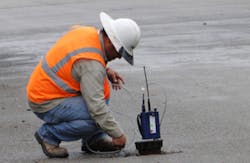Leak detection has proven to be a critical component for the management of water distribution systems, with the goal being not only to conserve water, but also to save energy and money. Pipe leak detection — testing for, finding and repairing leaking pipes — is a major part of ongoing asset management programs for water utilities, especially those with chronic water loss problems. The need for modern leak detection technologies is only expected to grow as the country’s water infrastructure ages and deteriorates. According to the Environmental Protection Agency (EPA, epa.gov), the majority of publicly owned water treatment works in the U.S. were constructed during the 1970s and 1980s. And as drinking water and wastewater systems continue to age, some system components are more than 100 years old.
Risks associated with aging infrastructure and water loss
Michael Royer, physical scientist with the EPA (epa.gov), says he expects aging and deteriorating infrastructure is a substantial contributor to water leakage. “Leakage from joints, pin holes, cracks, connections and valves can be expected to become worse over time due to the cumulative effects of factors such as corrosion, differential settling of soil, traffic loads, water hammer and temperature,” he says. Leakage depletes water supply, which can cause supply shortages in many areas. In addition, leakage may wash away the pipe bedding leading to loss of support and accelerated failure.
Aging and deteriorating infrastructure can increase main breaks, which cause loss of water service, loss of fire protection, flooding, damage to surrounding infrastructure, damage to homes and businesses, disruption of traffic and business and response costs. Royer says main breaks can result in contaminants entering the distribution system at the site of the break or through other holes and cracks if the water pressure falls below the water pressure on the exterior of the pipe. According to the EPA, there are 240,000 water main breaks per year in the U.S. The number of breaks increases substantially near the end of the system’s service life. In addition, Royer says holes and joint or appurtenance leaks pose another risk — offering a route for contaminant entry during transient or longer-term low-pressure events.
This is a condensed version of an article that appeared in Flow Control. To read this entire article, visit FlowControlNetwork.com.


